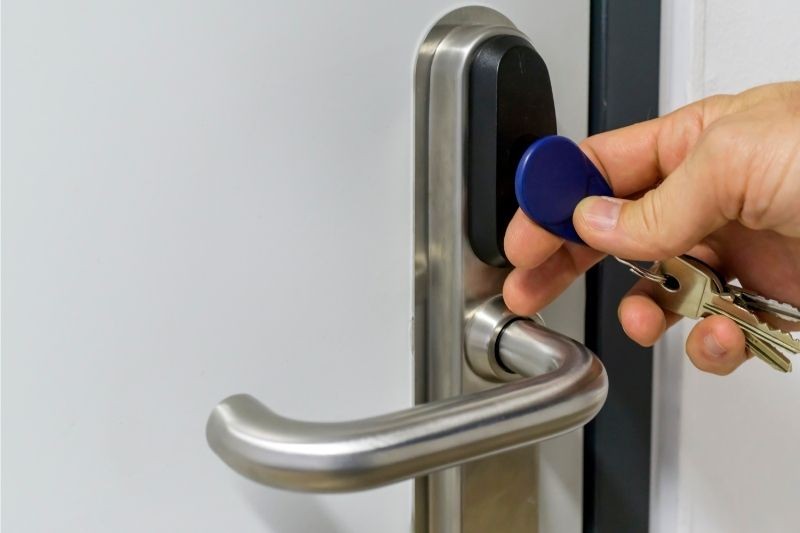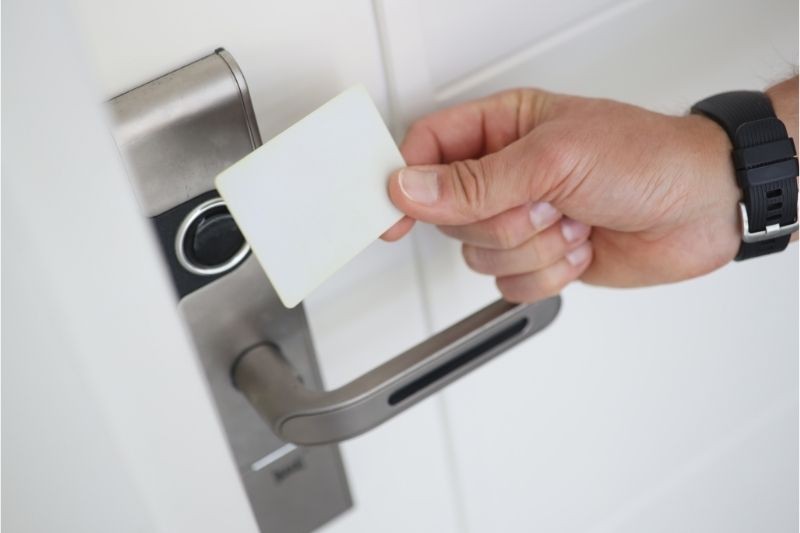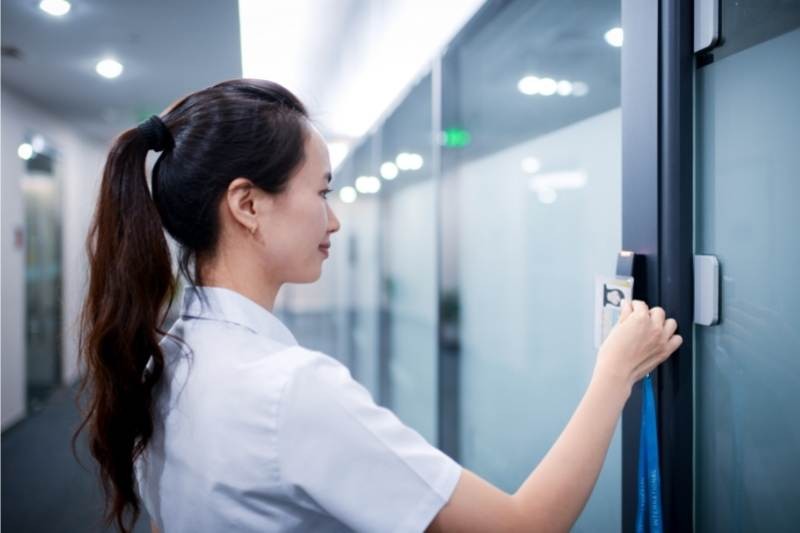Securing access to your commercial property is a paramount concern for business owners and property managers alike. Finding a balance between robust security and ease of access for tenants and staff is a critical decision. Commercial key fob door lock systems have emerged as a popular option, often touted for their convenience. But are they truly the best solution for your business’s security needs? This guide delves into the intricacies of commercial key fob door lock systems to help you determine if they are the right choice for your building.
Understanding Commercial Key Fob Door Lock Systems
A commercial key fob door lock system is essentially an electronic access control system that utilizes key fobs as credentials to unlock doors. These systems are designed for commercial applications, emphasizing durability and security for businesses and organizations. Think of them as an upgrade from traditional key and lock systems, offering a more controlled and trackable method of entry.
But what exactly constitutes a key fob system in this context? In commercial buildings, a key fob system operates as a streamlined electronic access control solution. Instead of physical keys, authorized personnel are issued key fobs, which they scan at a reader to gain entry. This is conceptually similar to key card systems, but with the more compact and user-friendly fob form factor.
Key components of a typical commercial key fob door lock system include:
- Access Reader: This is the device mounted at the door that reads the information from the key fob.
- Key Fobs (Credentials): These are the electronic devices issued to users. They contain a chip or sensor that communicates with the access reader.
- RFID Door Lock: Often an RFID door lock, this component secures the door. It uses radio-frequency identification (RFID) to communicate with the access reader, unlocking when a valid fob is presented.
Commercial key fob systems are frequently deployed in various locations within office buildings and industrial facilities, such as:
- Sensitive Utility Rooms
- Management and Staff-Only Zones
- Individual Office Suites
- Shared Amenity Spaces
- Restrooms
- Access Points to Roof or Restricted Areas
- Maintenance and Storage Areas
How Commercial Key Fob Systems Function
The operational mechanism of a commercial key fob door lock system relies on electronic or magnetic locking mechanisms to control door access.
Here’s a breakdown of the process:
- Fob Presentation: An authorized individual presents their key fob to the access reader installed at the door.
- Credential Verification: The access reader utilizes RFID technology to read and verify the credential embedded in the key fob.
- Access Grant (or Denied): If the scanned key fob contains a valid and authorized credential, the access reader sends a signal to the electronic door lock. This signal triggers the lock to release, granting entry. If the credential is invalid, access is denied.
To further understand the technology involved, exploring the differences between electric locks vs. magnetic locks can provide valuable context regarding the locking mechanisms often used in these systems.
Commercial Grade Locks: What Makes Them Different?
Commercial door locks stand apart from residential locks due to their construction and intended use. They are specifically engineered for the high-traffic demands of commercial environments like office buildings, industrial complexes, hospitals, and various commercial real estate developments.
A “commercial-grade” lock signifies the highest tier of lock quality. These locks are built for superior security, crafted with greater precision, and constructed from more durable materials than standard residential locks. They are designed to withstand heavy use, resist forced entry attempts, and provide reliable performance over extended periods. This robust construction is crucial for maintaining security and minimizing maintenance in busy commercial settings.
Cost Considerations for Commercial Key Fob Locks
Implementing a commercial key fob lock system involves a financial investment. The cost of a commercial key fob lock system typically ranges from $1,300 to $2,000, excluding professional installation fees. It’s also important to factor in the cost of replacement key fobs, which can vary from approximately $50 to $400 per fob.
For properties with multiple tenants or a large staff, the cost of issuing and potentially replacing key fobs for each user can accumulate. Therefore, budgeting for both the initial system installation and the ongoing operational costs, including key fob management, is essential when considering this type of access control.
Advantages and Disadvantages of Commercial Key Fob Systems
Before deciding on commercial key fob door locks for your building, carefully weigh the pros and cons.
| Advantages of Commercial Key Fob Door Lock Systems | Disadvantages of Commercial Key Fob Door Lock Systems |
|---|---|
| Fast Entry: Key fobs offer quick and convenient access for authorized personnel. | Lost or Stolen Fobs: Similar to traditional keys, key fobs are susceptible to being easily lost or stolen, creating security vulnerabilities. |
| Easy Installation: Compared to more complex systems, key fob door locks are generally straightforward to install. | Not Hands-Free: Key fobs require physical interaction for access, which can be inconvenient in certain situations. |
| Offline Operation: They operate independently of WiFi or Bluetooth, ensuring functionality even during network outages. | Limited Guest Access: Commercial key fob systems typically lack a built-in mechanism for easy guest access management. |
| Relatively Low Credential Cost: Key fobs are generally less expensive to procure and replace than some other access credentials. | No Smartphone Integration: They do not offer the convenience of smartphone-based entry, which is increasingly desired by users. |




In essence, commercial key fobs provide a marginal improvement over traditional brass keys. Their primary advantage lies in the speed and ease of unlocking doors compared to the sometimes-fumbling process of using a physical key. However, they inherit many of the security and management limitations associated with traditional key systems.
While not ideal as a primary access control system for all entry points, commercial key fob systems can still be valuable in specific contexts within a building. They are particularly effective for securing restricted, staff-only areas where access control needs are less dynamic and primarily limited to authorized personnel with assigned fobs or key cards.
Exploring Alternatives to Commercial Key Fob Door Locks
For businesses seeking more advanced and versatile access control solutions, several alternatives to commercial key fob door lock systems are available:
- Commercial Keypad Door Locks: These systems utilize numerical keypads or touchscreens for entry. Access is granted by entering a pre-programmed PIN code.
- Smart Locks: Commercial smart locks are electronic locks that can be controlled remotely via smartphones and often offer advanced features like activity logging and remote access management. Many integrate with mobile apps for enhanced control.
- Keypad Access Control Devices: These are standalone access control units installed near doors. They typically feature keypads and may also incorporate mobile app integration for smartphone-based access, offering a more comprehensive access management solution.
Understanding how ButterflyMX keypads work can provide a clearer picture of the capabilities of modern keypad-based access control systems.
Why Modern Access Control Systems Outperform Key Fobs
For comprehensive access management in larger commercial properties, advanced systems like the ButterflyMX Keypad offer significant advantages over traditional key fob door lock systems. These modern, smartphone-powered systems are designed to streamline both tenant and visitor access while enhancing security and convenience.
Key benefits of advanced access control systems like ButterflyMX include:
- Simplified Guest Access: Tenants can easily grant temporary access to visitors remotely through PIN codes, eliminating the need for physical key exchange.
- Easy Installation & Integration: Systems like ButterflyMX Keypads are designed for straightforward installation, often integrating with existing electronic door hardware.
- Enhanced Security with Audit Trails: Integrated security cameras capture images of each entry attempt, and comprehensive user logs are maintained, providing a detailed audit trail for enhanced security and accountability.
- Automatic Software Updates & Maintenance: Cloud-based systems ensure automatic software updates and remote troubleshooting, minimizing downtime and maintenance overhead.
- Cloud-Based Management: Tenant information and access logs are securely stored and managed in the cloud, offering centralized control and accessibility.
- Smartphone-Based Convenience: Tenants can utilize their smartphones for door entry, and manage guest access directly from their mobile devices, offering a seamless and user-friendly experience.
In conclusion, while commercial key fob door lock systems offer a basic level of electronic access control and are suitable for specific limited-access areas, they fall short as a comprehensive security solution for modern commercial buildings. For businesses prioritizing robust security, streamlined access management, and user convenience, exploring advanced, smartphone-integrated access control systems is a worthwhile investment.